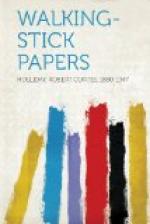Canes have figured prominently in humour. The Irishman’s shillelagh was for years a conspicuous feature of the comic press. And there will instantly come to every one’s mind that immortal passage in “Tristram Shandy.” Trim is discoursing upon life and death:
“Are we not here now, continued the Corporal (striking the end of his stick perpendicularly upon the floor, so as to give an idea of health and stability)—and are we not (dropping his hat upon the ground) gone! in a moment!—’Twas infinitely striking! Susannah burst into a flood of tears.”
Canes are not absent from poetry. Into your ears already has come the refrain of “The Last Leaf”:
“And totters o’er the ground,
With his cane.”
And, doubtless, floods of instances of canes that the world will not willingly let die will occur to one upon a moment’s reflection.
Canes are inseparable from art. All artists carry them; and the poorer the artist the more attached is he to his cane. Canes are indispensable to the simple vanity of the Bohemian. One of the most memorable drawings of Steinlen depicts the quaint soul of a child of the Latin Quarter: an elderly Bohemian, very much frayed, advances wreathed in the sunshine of his boutonniere and cane. Canes are invariably an accompaniment of learning. Sylvester Bonnard would of course not be without his cane; nor would any other true book-worm, as may be seen any day in the reading-room of the British Museum and of the New York Public Library. It is, indeed, indisputable that canes, more than any other article of dress, are peculiarly related to the mind. There is an old book-seller on Fourth Avenue whose clothes when he dies, like the boots of Michelangelo, probably will require to be pried loose from him, so incessantly has he worn them within the memory of man. None has ever looked upon him in the open air without his cane. And is not that emblem of omniscience and authority, the schoolmaster’s ferule, directly of the cane family? So large has the cane loomed in the matter of chastisement that the word cane has become a verb, to cane.
There was (in the days before the war) a military man (friend of mine), a military man of the old school, in whom could be seen, shining like a flame, a man’s great love of a cane. He had lived a portion of his life in South America, and he used to promenade every pleasant afternoon up and down the Avenue swinging a sharply pointed, steel-ferruled swagger-stick. “What’s the use of carrying that ridiculous thing around town?” some one said to him one day.




